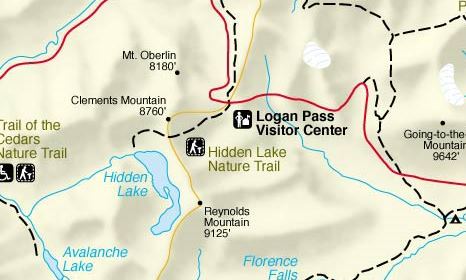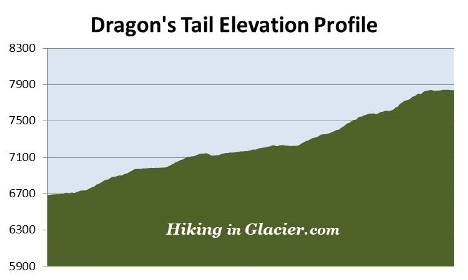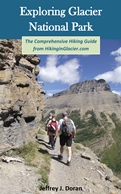
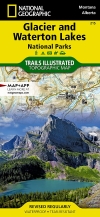
The Dragon's Tail
| Trail Features: | Outstanding views, Alpine meadows, Lake | 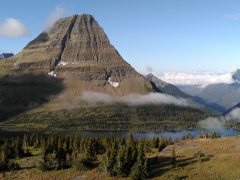 |
|||
| Trail Location: | Logan Pass Visitor Center | ||||
| Roundtrip Length: | 5.4 Miles | ||||
| Total Elevation Gain: | 1190 Feet | ||||
| Avg. Elev Gain / Mile: | 441 Feet | ||||
| Highest Elevation: | 7845 Feet | ||||
| Trail Difficulty Rating: | 7.78 (moderate) | ||||
| Parking Lot Latitude | 48.69539 | ||||
| Parking Lot Longitude | -113.71826 | ||||
Trail Description:
The hike to the Dragon's Tail in Glacier National Park begins from the west side of the Logan Pass Visitor Center. Once on the back side of the visitor center, after climbing the stairway, stay towards the right and look for the Hanging Gardens Trailhead. The trail is more commonly referred to as the Hidden Lake Nature Trail (represented by the red line on the map below).
The entire length of this hike is completely open and exposed to the elements. As you ascend across the alpine meadows known as the Hanging Gardens you should expect a variety of weather conditions, including sun, wind, rain and cooler temperatures. You should also expect extreme crowds, as the Hidden Lake Overlook area is one of the most popular destinations in Glacier. As a result, parking is usually an issue during peak tourist season. If you wish to avoid the crowds I highly recommend starting your hike as early in the morning as possible, or using the park's free shuttle system.
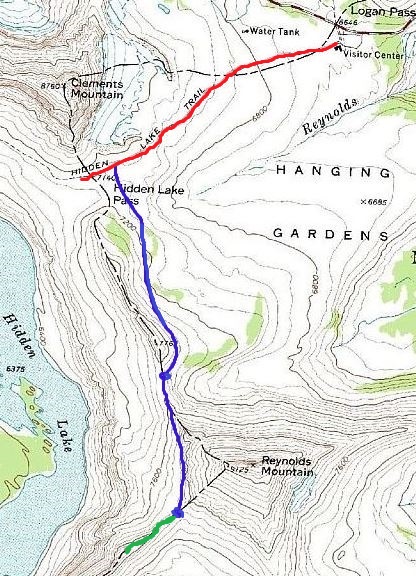 The hike begins along a paved surface that quickly turns into a raised boardwalk after walking a short distance. At this lofty elevation snow tends to linger around well into the summer. The boardwalk helps to keep hikers above the snow, slush, mud and rivulets. Once the snow melts, however, the Hanging Gardens becomes an incredibly beautiful carpet of wildflowers.
The hike begins along a paved surface that quickly turns into a raised boardwalk after walking a short distance. At this lofty elevation snow tends to linger around well into the summer. The boardwalk helps to keep hikers above the snow, slush, mud and rivulets. Once the snow melts, however, the Hanging Gardens becomes an incredibly beautiful carpet of wildflowers.
As you proceed upwards during the early portions of your hike, 8760-foot Clements Mountain will dominate the landscape directly in front of you. Looking towards the north, on your right, hikers will enjoy outstanding views of the Garden Wall. Standing towards the northwest is 8180-foot Mt. Oberlin.
A little more than a half-mile from the visitor center, after climbing a series of wooden steps, hikers will reach the end of the first boardwalk section. From here the trail shifts to a more southwesterly course, and begins heading in the direction of Bearhat Mountain. Both 9125-foot Mt. Reynolds and 8016-foot Heavy Runner Mountain will be on your left as you proceed along this stretch.
Even relatively late into the season it's possible you'll have to traverse across a couple of small snowfields as you ascend towards Hidden Lake Pass. There may be a couple of patches along the Reynolds Route as well.
At just over a mile from the trailhead hikers will reach a small rise, and then shortly thereafter will pass a small tarn on the left. Just before reaching a second tarn, at roughly 1.15 miles from the trailhead, an unmarked trail will branch-off to the left. This side trail, known as the Reynolds Route, is well defined by rocks lining both sides of the path for the first several yards (the blue line on the map above represents the Reynolds Route). In case you need them, the GPS coordinates for this junction are 48.68780, –113.73764. The Hidden Lake Trail continues for another two-tenths of a mile to reach Hidden Lake Overlook, and then another 1.4 miles to reach the northeastern shore of the lake. Hikers should note that both tarns atop Hidden Lake Pass may be dry late in the season.
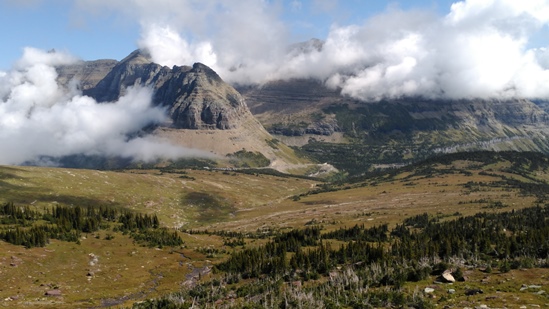
Almost immediately after turning onto the Reynolds Route hikers will leave behind the extreme crowds making their way to and from Hidden Lake Overlook. After briefly walking through a pleasant alpine meadow the trail begins to climb the talus slopes of the Continental Divide. Just above the base of the climb the trail splits, but reconnects further up the ridge. Hikers should take the right fork to proceed towards the first pass. As you ascend along these rugged slopes you’ll enjoy fantastic views of the towering peaks that surround Logan Pass and the Hanging Gardens.
At 2.1 miles hikers will reach the first pass on this route. This pass, or saddle, is located along the ridge that extends north from Reynolds Mountain. From this vantage point you'll be standing atop the Continental Divide overlooking Hidden Lake towards the west, with 8684-foot Bearhat Mountain rising almost directly above its opposite shore. Standing above the north end of the lake is Clements Mountain, and tucked between those two peaks is 8952-foot Mount Cannon. Heavy Runner Mountain will be the dominating feature looking directly towards the east. Looking further to your left from this perch will be Going-To-The-Sun Mountain, Matahpi Peak and Piegan Mountain.
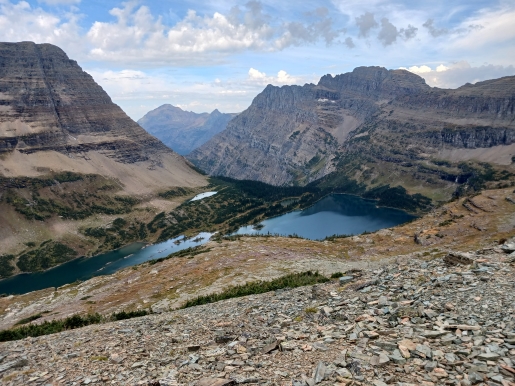
From the pass the trail continues up the spine of the ridge for a short distance, and then begins to ascend along the western slopes of Reynolds Mountain. This section of trail travels across talus fields along a narrow path, while passing over some fairly steep terrain. Though the exposure to steep drop-offs is fairly minimal, people with a fear of heights may not particularly care for this stretch.
At 2.7 miles hikers will reach the second pass, which also represents the endpoint for this hike. This saddle lies between Reynolds Mountain and the Dragon’s Tail. This perch also offers outstanding panoramic views of Hidden Lake, as well as Fusillade Mountain, Blackfoot Mountain, Blackfoot Glacier and Mt. Logan towards the south. From the pass a climbing route continues up the spine of the Dragon’s Tail, and allows you to proceed as far as you're comfortable. As you climb higher you'll encounter increasing levels of exposure to steep drop-offs, and in places will be required to do some mild scrambling (the green line on the map above follows the lower segment of the Dragon’s Tail). Roughly a hundred yards beyond the saddle the route becomes a technical climb, and shouldn’t be attempted by novices.
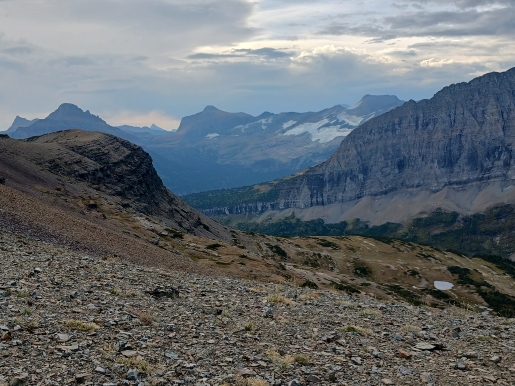
Despite being unmarked, and not on the official park map, the entire route up to the second pass is well defined and very easy to follow. Please note, however, that early season hikers may have to do some route finding in some areas where lingering snow still covers the path; therefore, it’s still a good idea to carry a good topographic trail map.
